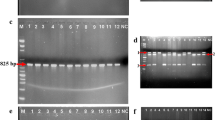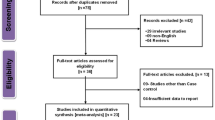Abstract
The association between vitamin D receptor (VDR) gene polymorphisms and risk of benign prostatic hyperplasia (BPH) has been investigated in numerous publications, but published results remain inconclusive. Hence, we conducted this meta-analysis to derive a more precise conclusion. Four polymorphisms (Taq-I, Bsm-I, Apa-I, and Fok-I) of the VDR gene with risk of BPH from six case–control studies and one cohort study involving 2,248 individuals were identified from PubMed and China National Knowledge Internet databases up to November 20, 2013 (updated on March 5, 2014). After data extraction, the meta-analysis was performed using Comprehensive Meta-Analysis software. All four VDR polymorphisms were not associated with the risk of BPH [Taq-I: OR 0.61, 95 % CI (0.38–1.24) for tt vs. TT; Bsm-I: OR 1.27, 95 % CI (0.96–1.69) for bb vs. BB; Apa-I: OR 1.26, 95 % CI (0.64–2.46) for aa vs. AA; Fok-I: OR 0.95, 95 % CI (0.60–1.50) for ff vs. FF]. Subgroup analysis according to ethnicity for Taq-I polymorphism also showed that the polymorphism was not associated with risk of BPH for either Caucasians [OR 0.74, 95 % CI (0.31–1.78) for tt vs. TT] or Asians [OR 0.35, 95 % CI (0.11–1.11) for tt vs. TT]. However, results of this meta-analysis should be treated with caution because this meta-analysis has several limitations. We propose to conduct a high-quality study with large sample size to further identify the association between VDR gene polymorphisms and BPH susceptibility.

Similar content being viewed by others
References
Roehrborn C (2008) Pathology of benign prostatic hyperplasia. Int J Impot Res 20:S11–S18
Priest R, Garzotto M, Kaufman J (2012) Benign prostatic hyperplasia: a brief overview of pathogenesis, diagnosis, and therapy. Tech Vasc Interv Radiol 15(4):261–264. doi:10.1053/j.tvir.2012.10.001
Santos Dias J (2012) Benign prostatic hyperplasia: clinical manifestations and evaluation. Tech Vasc Interv Radiol 15(4):265–269. doi:10.1053/j.tvir.2012.09.007
Larsen B, Post GJ (2013) LUTS: a practical guide to alleviating lower urinary tract symptoms. JAAPA 26(3):26–30
Pinheiro LC, Martins Pisco J (2012) Treatment of benign prostatic hyperplasia. Tech Vasc Interv Radiol 15(4):256–260. doi:10.1053/j.tvir.2012.09.004
Luo J, Dunn T, Ewing C, Sauvageot J, Chen Y, Trent J, Isaacs W (2002) Gene expression signature of benign prostatic hyperplasia revealed by cDNA microarray analysis. Prostate 51(3):189–200
Bassil N (2012) Testicular function. Pathy’s principles and practice of geriatric medicine, vols 1, 2, 5th edn. pp 1211–1223
Sanda M, Beaty T, Stutzman R, Childs B, Walsh P (1994) Genetic susceptibility of benign prostatic hyperplasia. J Urol 152(1):115–119
Platz EA, Kawachi I, Rimm EB, Willett WC, Giovannucci E (2000) Race, ethnicity and benign prostatic hyperplasia in the health professionals follow-up study. J Urol 163(2):490–495
Pearson JD, Lei H–H, Beaty TH, Wiley KE, Isaacs SD, Isaacs WB, Stoner E, Walsh PC (2003) Familial aggregation of bothersome benign prostatic hyperplasia symptoms. Urology 61(4):781–785
Negri E, Pelucchi C, Talamini R, Montella M, Gallus S, Bosetti C, Franceschi S, La Vecchia C (2005) Family history of cancer and the risk of prostate cancer and benign prostatic hyperplasia. Int J Cancer 114(4):648–652
Konwar R, Chattopadhyay N, Bid HK (2008) Genetic polymorphism and pathogenesis of benign prostatic hyperplasia. BJU Int 102(5):536–544
Geovanni Espinosa N, Esposito R, Kazzazi A, Djavan B (2013) Vitamin D and benign prostatic hyperplasia-a review. Can J Urol 20(4):6821
Uitterlinden AG, Fang Y, van Meurs JB, Pols HA, van Leeuwen JP (2004) Genetics and biology of vitamin D receptor polymorphisms. Gene 338(2):143–156
Bousema JT, Bussemakers MJ, van Houwelingen KP, Debruyne FM, Verbeek A, Kiemeney L (2000) Polymorphisms in the vitamin D receptor gene and the androgen receptor gene and the risk of benign prostatic hyperplasia. Eur Urol 37(2):234–238
Habuchi T, Suzuki T, Sasaki R, Wang L, Sato K, Satoh S, Akao T, Tsuchiya N, Shimoda N, Wada Y (2000) Association of vitamin D receptor gene polymorphism with prostate cancer and benign prostatic hyperplasia in a Japanese population. Cancer Res 60(2):305–308
Hamasaki T, Inatomi H, Katoh T, Ikuyama T, Matsumoto T (2002) Significance of vitamin D receptor gene polymorphism for risk and disease severity of prostate cancer and benign prostatic hyperplasia in Japanese. Urol Int 68(4):226–231
Chaimuangraj S, Thammachoti R, Ongphiphadhanakul B, Thammavit W (2006) Lack of association of VDR polymorphisms with Thai prostate cancer as compared with benign prostate hyperplasia and controls. Asian Pac J Cancer Prev 7(1):136
Huang SP, Huang CY, Wu WJ, Pu YS, Chen J, Chen YY, Yu CC, Wu TT, Wang JS, Lee YH (2006) Association of vitamin D receptor FokI polymorphism with prostate cancer risk, clinicopathological features and recurrence of prostate specific antigen after radical prostatectomy. Int J Cancer 119(8):1902–1907
Mullan RJ, Bergstralh EJ, Farmer SA, Jacobson DJ, Hebbring SJ, Cunningham JM, Thibodeau SN, Lieber MM, Jacobsen SJ, Roberts RO (2006) Growth factor, cytokine, and vitamin D receptor polymorphisms and risk of benign prostatic hyperplasia in a community-based cohort of men. Urology 67(2):300–305
Manchanda PK, Konwar R, Nayak VL, Singh V, Bid HK (2010) Association of genetic variants of the vitamin D receptor (VDR) gene (Fok-I, Taq-I and Bsm-I) with susceptibility of benign prostatic hyperplasia in a North Indian population. Asian Pac J Cancer Prev 11:1005–1008
Stroup DF, Berlin JA, Morton SC, Olkin I, Williamson GD, Rennie D, Moher D, Becker BJ, Sipe TA, Thacker SB (2000) Meta-analysis of observational studies in epidemiology: a proposal for reporting. Meta-analysis Of Observational Studies in Epidemiology (MOOSE) group. JAMA 283(15):2008–2012
Coory MD (2010) Comment on: heterogeneity in meta-analysis should be expected and appropriately quantified. Int J Epidemiol 39(3):932-932
Acknowledgments
This work was partly supported by grants from the Natural Science Foundation of China) (No. 81172734) and Foundation of Wuhan University (No. 111086), without commercial or for-profit organs. No additional external funding received for this study.
Conflict of interest
All authors declared there was none conflict of interest.
Author information
Authors and Affiliations
Corresponding author
Additional information
Xian-Tao Zeng and Qi-Sheng Yao are co-first authors.
Electronic supplementary material
Below is the link to the electronic supplementary material.
Figure S3. Forest plot for Taq-I polymorphism based on (tt + TT) vs. TT genetic model (TIFF 2455 kb)
Figure S4. Forest plot for Taq-I polymorphism based on tt vs. (tT + TT) genetic model (TIFF 2458 kb)
Rights and permissions
About this article
Cite this article
Zeng, XT., Yao, QS., Weng, H. et al. Meta-analysis of vitamin D receptor gene polymorphisms and benign prostatic hyperplasia risk. Mol Biol Rep 41, 6713–6717 (2014). https://doi.org/10.1007/s11033-014-3554-2
Received:
Accepted:
Published:
Issue Date:
DOI: https://doi.org/10.1007/s11033-014-3554-2




